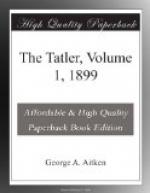One indication of the popularity of the Tatler in its own day is the long subscription list prefixed to the reprint in four octavo volumes. Some copies were printed on “royal,” others on “medium” paper; and the price of the former was a guinea a volume, while that of the latter was half a guinea. There was also an authorised cheap edition, in duodecimo, at half a crown a volume, besides a pirated edition at the same price. A still more conclusive proof of the success of the Tatler was the number of papers started in imitation of its methods. Addison mentioned some of those periodicals in No. 229, where details will be found of the “Female Tatler,” “Tit for Tat,” and the like. But besides these, several spurious continuations of the Tatler appeared directly after the discontinuance of the genuine paper, including one by William Harrison, written with Swift’s encouragement and assistance. But Harrison, as Swift said, had “not the true vein for it,” and his paper reached only to fifty-two numbers, which were afterwards reprinted as a fifth volume to the collected edition of the original Tatler. Gay said that Steele’s imitators seemed to think “that what was only the garnish of the former Tatlers was that which recommended them, and not those substantial entertainments which they everywhere abound in.” The town, in the absence of anything better, welcomed their occasional and faint endeavours at humour; “but even those are at present become wholly invisible, and quite swallowed up in the blaze of the Spectator.” Steele himself said that his imitators held the censorship in commission.




